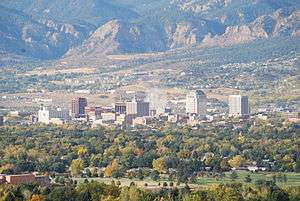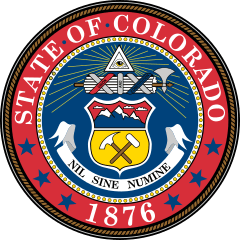Cheyenne Mountain
Cheyenne Mountain is a triple-peaked mountain in El Paso County, Colorado, southwest of downtown Colorado Springs. The mountain serves as a host for military, communications, recreational, and residential functions. The underground operations center for the North American Aerospace Defense Command (NORAD) was built during the Cold War to monitor North American airspace for missile launches and Soviet military aircraft. Built deep within granite, it was designed to withstand the impact and fallout from a nuclear bomb. Its function broadened with the end of the Cold War, and then many of its functions were transferred to Peterson Air Force Base in 2006.
| Cheyenne Mountain | |
|---|---|
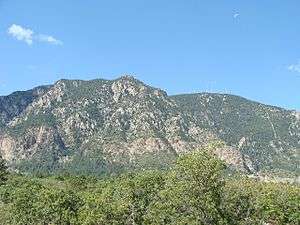 | |
| Highest point | |
| Elevation | 9,570 ft (2,920 m) |
| Prominence | 1,141 ft (348 m) [1] |
| Isolation | 1.87 mi (3.01 km) [1] |
| Coordinates | 38°44′13″N 104°52′51″W |
| Geography | |
 Cheyenne Mountain | |
| Location | El Paso County, Colorado, U.S.[2] |
| Parent range | Rampart Range[1] |
| Topo map | USGS 7.5' topographic map Mount Big Chief, Colorado[1] |
Homesteading on the mountain began in 1867 and the mountain was the site of resorts and retreats beginning in the 1880s. Spencer Penrose, who built The Broadmoor in 1918, bought many of the properties on the mountain and built the Cheyenne Mountain Zoo, Cheyenne Mountain Highway, Will Rogers Shrine of the Sun, a lodge on one of the mountain peaks, and a retreat at Emerald Valley. The site of the lodge has become a wilderness Cloud Camp and Emerald Valley is now the site of The Broadmoor's Ranch at Emerald Valley. Land on Cheyenne Mountain that had once been owned by The Broadmoor is now the site of luxury homes. A community, Overlook Colony, that began in 1911 still resides on the mountain.
The two parks on and at the base of Cheyenne Mountain are Cheyenne Mountain State Park and North Cheyenne Cañon Park. A noticeable feature on the top of one of Cheyenne Mountain's peaks is an antenna farm with transmitters for cellular phone, radio, television, and law enforcement transmitters.
Geography
Cheyenne Mountain has three peaks. The southern peak is Cheyenne Mountain's summit at 9,200 feet (2,800 m) in elevation. It was formerly called Mount Albrecht. The antenna farm sits on the middle peak. The northern peak, The Horns, may look to some like the head of a dragon or horns.[3][lower-alpha 1] The peak is 9,200 feet (2,800 m) in elevation.[3]
The mountain's boundaries are Rock Creek, which flows from Mount Big Chief through Cheyenne Mountain to the town of Fountain, to the south and Cheyenne Cañon to the north.[3][5] The western side of Cheyenne Mountain is in Pike National Forest,[6][7] within the Pikes Peak Ranger District.[8] Colorado Springs' skyline features Cheyenne Mountain and Pikes Peak. Other mountain peaks are Mount Arthur, Mount Baldy, Mount Rosa, Cameron's Cone, and Mount Garfield.[9]
History
Early history
Cheyenne Mountain was named for the Cheyenne people. Native Americans found that Cheyenne Mountain was a good source of wood for teepee poles. It was visited by Cheyenne and Arapaho people, who may have sought spiritual inspiration from the mountain's waterfalls.[10] Cheyenne Mountain was used by Ute Native Americans to cross from the plains and benefit from the "steep slopes and hidden valleys" to safely travel from enemy tribes that had their horses stolen by the Utes.[11]:1
Late 19th century
William Dixon, a rancher, claimed a homestead in the Cheyenne Mountain foothills in 1867. He built a tavern along a trail up Cheyenne Mountain and turned the trail into a toll road, now called Old Stage Road, to Cripple Creek. The road begins as a paved road and is then a dirt road through Pike National Forest. His homestead ultimately became part of The Broadmoor resort.[3]
| People |
|---|
| Coal mining areas |
| Other mining topics |
The Cheyenne Mining District was located on Cheyenne Mountain.[12] The Little Suzie gold mine was built by a group of prospectors in the 1870s.[13] Silver and minerals were mined on Cheyenne Mountain in 1883.[14][15] Towns or resorts built on Cheyenne Mountain included the original Bruin Inn (1884),[16][lower-alpha 2] Watsonville (town named in 1884)[17] and Wade City, also called Wade's Resort, (1885).[16][18][lower-alpha 3] The first mining claims granted for El Paso County were for the Manganese and Rio Grande lodes on Cheyenne Mountain by January 31, 1885.[20]
 Cheyenne Mountain, 1898–1905
Cheyenne Mountain, 1898–1905
Early 20th century
The Colorado Springs and Cripple Creek District Railway (Short Line) traversed Cheyenne Mountain during the trip between Cripple Creek and Colorado Springs by 1905. It transported coal, mined ore, and passengers.[21] Also at that time, a carriage road went to Seven Lakes and the summit of Pikes Peak from Cheyenne Mountain.[21]
Grace Lutheran Church built a retreat in Emerald Valley in 1904. It is now The Broadmoor's Ranch at Emerald Valley.[22][lower-alpha 4] In 1905, Dr. August McKay homesteaded on 120 acres on the east slope of Cheyenne Mountain. He developed a series of trails and rest houses that led to The Sunshine Inn that he built as a health resort above Old Stage Road. The property was purchased by Spencer Penrose, who had the inn torn down.[3][23]
The Overlook Colony was started in 1911 by a group of Colorado College professors. It first started as a summer retreat for the educators, and grew to include musicians, doctors, artists, generals, oilmen, and an ambassador to India. The Cheyenne Mountain Zoo was built just below and the Will Rogers Shrine built just above this community. Residents manage the Overlook Colony Mutual Water Company that governs water conservation, maintenance, and testing of the water supply from deep within the former Little Susie gold mine.[13]
Bert Swisher and Thomas Dixon homesteaded on Cheyenne Mountain in 1917. Dixon resided with his family in a cabin near the top of the mountain in the middle of three valleys. Swisher's cabin was near the present site of the antenna farm at the top of the mountain, which was accessed by Old Stage Road.[11]:1:2
Spencer Penrose and The Broadmoor
Cheyenne Mountain became a successful recreational and resort area when Spencer Penrose developed The Broadmoor resort in 1918.[24][11]:1 The Cheyenne Mountain Cog Railroad provided narrow gauge cog railway service to South Cheyenne Cañon from the Broadmoor Casino beginning in 1918. It later offered service from The Broadmoor to the Cheyenne Mountain Zoo. Service ended in 1974.[25]
In the 1920s, Penrose began to develop on Cheyenne Mountain property on the northern peak that he bought in 1915. He built the Cheyenne Mountain Highway in 1925.[3] In 1926, the Cheyenne Mountain Lodge opened at the top of Cheyenne Mountain. It had a restaurant, a suite for Penrose on the third floor, four guest rooms, and living quarters for servants.[26] Visitors could make the trip up the Cheyenne Mountain Highway on the backs of elephants.[3] The lodge closed in 1961. It was razed in 1976 following years of destruction by vandals. It is now the site of The Broadmoor's Cloud Camp lodge and cabins.[26]
 The Broadmoor resort, with Cheyenne Lake in the foreground and Cheyenne Mountain in the left half of the background
The Broadmoor resort, with Cheyenne Lake in the foreground and Cheyenne Mountain in the left half of the background
Penrose developed the country's highest zoo at 6,800 feet (2,100 m) in elevation,[27] the Cheyenne Mountain Zoo (1926) on the mountain and Will Rogers Shrine of the Sun (1937) on the northern promontory of the mountain.[28][11]:1[lower-alpha 5] The Cheyenne Mountain Highway was built for transport to the zoo, shrine, and top of the mountain.[31]:222 The Broadmoor built a ski area on Cheyenne Mountain in 1959. In 1986, the resort closed Ski Broadmoor, but the city of Colorado Springs and Ski Vail stepped in to keep it open. It closed in 1991.[28] The land was sold to the Broadmoor Resort Community Association.[3] Land that had once been owned by The Broadmoor on the mountain was sold and is now the site of luxury homes.[29]:92
 Will Rogers Shrine of the Sun
Will Rogers Shrine of the Sun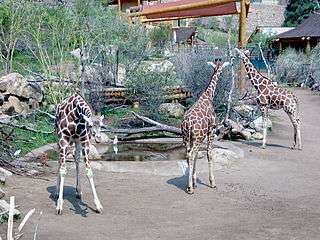 Giraffes, Cheyenne Mountain Zoo
Giraffes, Cheyenne Mountain Zoo
NORAD operations center
In the 1950s, during the Cold War, the interior of the mountain became a site for the operations center for the North American Aerospace Defense Command (NORAD).[11]:1 The center, deep within Cheyenne Mountain, was completed in 1966 after spending $142 million and using 500 tons of explosives. The result was an underground city operated by the Air Force.[3] Popular Science wrote in 1965, before the dedication of the facility, that Cheyenne Mountain is the only mountain known to have buildings constructed on the inside of a mountain. It was built to withstand being bombed: eleven multiple-story buildings stand on coil springs to absorb the shock of a blast and it was designed so that up to 800 people could survive fall-out of a nuclear bomb. The buildings are encased in steel, surrounded by granite, and the facility is behind blast-proof doors. It was designed to be the "nerve center" for NORAD.[32]
The NORAD center has been staffed by Canadian and United States military personnel to monitor North American air space for intercontinental ballistic missiles and incoming Soviet military aircraft.[33][31]:194–195 Locally, this military boom during the Cold War included the establishment of the United States Air Force Academy, Peterson Air Force Base, and Fort Carson.[11]:1 After the Cold War, NORAD monitored objects orbiting the earth and aircraft without flight plans. It is also known for monitoring the Christmas Eve orbit of Santa Claus.[33]
NORAD used to offer public tours, but due to security concerns they were suspended in 1999. The off-ramp on NORAD road has been staffed by Air Force Security Police since September 11, 2001.[3] Most of the center's operations were moved to Peterson Air Force Base in Colorado Springs in 2006,[33] then in April 2015, the Pentagon reported that a few operations would be moving back in.
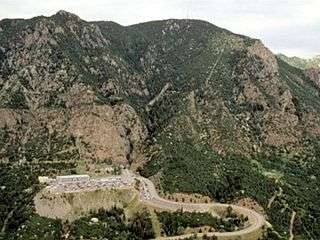 Aerial photograph of the NORAD parking lot, NORAD Road, and the antenna farm, 2011
Aerial photograph of the NORAD parking lot, NORAD Road, and the antenna farm, 2011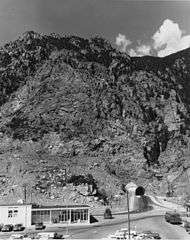 NORAD Entrance, Cheyenne Mountain,1968
NORAD Entrance, Cheyenne Mountain,1968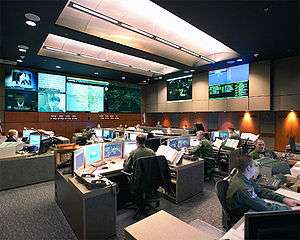 NORAD Command Center, United States Air Force photograph
NORAD Command Center, United States Air Force photograph
Antenna farm
During the 1950s, an antenna farm was built on the middle peak of the mountain[3][11]:1 when Bert Swisher deeded ten acres to Bud Edmonds and several backers and Swisher signed a non-compete agreement.[3][11]:2 Edmonds, John Browne, and Buck Ingersoll agreed to replace the trails to the area with a real road, which was opened in 1960 by the Cheyenne Propagation Company.[3] There are 700 cell phone, television, radio, and law enforcement transmitters on the antenna farm.[3] The Cheyenne Mountain radio site 145.160 repeater covers south central and southeast Colorado along the Interstate 25 corridor from Monument nearly to the New Mexico border.[34] In 2002, it was operated by the Cheyenne Propagation Company.[3]
Parks and recreation
Cheyenne Mountain State Park
The City of Colorado Springs and Colorado State Parks purchased 1,680 acres of land to preserve the "southeastern flank" of the mountain and its wildlife habitat in 2000.[35] The land, originally the JL Ranch,[lower-alpha 6] was slated for development of 2,500 houses.[35][11]:1[lower-alpha 7] The land was purchased to create the Cheyenne Mountain State Park,[11]:3 which is the only state park in El Paso County. An additional 1,021 acres at the top and east side of Cheyenne Mountain were acquired from 2007 to 2009. The park is now a total of 2,701 acres, part of which is at the base of the mountain and part of which is on Cheyenne Mountain.[35][36] It has 20 miles of trails.[35]
Cheyenne Cañon
The 1,600 acre North Cheyenne Cañon Park, Starsmore Discovery Center, Seven Falls, and some of Colorado Spring's "most exclusive neighborhoods" are located in Cheyenne Cañon.[27] The source of North Cheyenne Creek is in Teller County. South Cheyenne Creek's source, also in Teller County, is Mount Big Chief,[37][38][39] near St. Peter's Dome.[40] The flows through Seven Falls[41] in South Cheyenne Cañon.[42]
North Cheyenne Cañon Park was started when the city of Colorado Springs bought 640 acres in North Cheyenne Cañon from Colorado College in 1885. An additional 480 acres was donated by General William Jackson Palmer. That land included High Drive, Silver Cascade Falls, and Helen Hunt Falls. In 1909 the Park Commission called it "by far the grandest and most popular of all the beautiful cañons near the city" for its evergreen trees, waterfalls, Cheyenne Creek, and rock formations.[10] Moderate hikes in the canon include Mount Cutler and Columbine trails.[27]
The two creeks meet and form Cheyenne Creek near the intersection of North Cheyenne Canyon Road, South Cheyenne Canyon Road, and Cheyenne Boulevard.[43][44]
- North Cheyenne Cañon Park
- Starsmore Discovery Center, North Cheyenne Canon Park
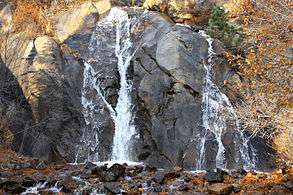 Helen Hunt Falls
Helen Hunt Falls
Historic trails
Two historic trails, only shown on the Pikes Peak Atlas, lead to the summit top of Cheyenne Mountain: the unofficial and faintly visible Swisher and the McNeil trails. At the top of the Swisher trail is a meadow and ruins of an old cabin.[45][lower-alpha 8]
In popular culture
- Helen Hunt Jackson's poem, Cheyenne Mountain was published by 1893.[46]
- In Robert Heinlein's 1966 The Moon Is a Harsh Mistress, a lunar colony's revolt against rule from Earth included the complete destruction of Cheyenne Mountain by rocks catapulted from the moon.
- A fictionalized Cheyenne Mountain NORAD base was the setting for the 1983 movie WarGames.
- Cheyenne Mountain is the base of the fictional SGC (Stargate Command) and the location of the stargate in the military science fiction show Stargate SG-1.
- The Mountain was featured in the 2016 film, Independence Day: Resurgence.
- It is an early command center for the human resistance in L. Ron Hubbard's "Battlefield Earth: A Saga of the Year 3000" (1982, ISBN 1-59212-007-5).
- The Mountain is a possible choice for the location of XCOM HQ in XCOM Long War, which offers the benefit of already being partially developed.
See also
- Cheyenne Mountain Country Club, in the Broadmoor neighborhood[9]
- Cheyenne Mountain School District 12, which includes Cheyenne Mountain Middle School and Cheyenne Mountain Elementary School
- Cheyenne Mountain Charter Academy
- Cheyenne Mountain High School
- List of Colorado mountain ranges
- List of Colorado mountain summits
- List of Colorado county high points
Notes
- An old Native American legend is that the mountain is the remains of a dragon that drank water from a flood, could not move from the weight, and died, leaving his image captured in the mountain's profile.[3] Legends of the lizard dragon with the great thirst were relayed to Spanish priests, recorded in manuscripts, and delivered to and stored in New Spain's capital and Madrid, Spain's archives. Another legend tells of a devil who lost a fight over land to the god Manitou, who took his dead body to a Cheyenne Mountain canyon, and the devil's horns are the only visible feature.[4]
- E. P. Tenney, a professor and the first president of Colorado College built a cabin in 1881 and the original Bruin Inn in North Cheyenne Cañon in 1884. There is a legend that the original building is incorporated within the current Bruin Inn.[16]
- Wade's Resort was also called Wade City. It was built by Joel H Wade about 1885 on the old Cripple Creek stage road (now Old Stage Road) along South Cheyenne Creek. Wade was the grandfather of Fred Barr. The town, a scheduled stop on the stage route to Cripple Creek, was torn down or burned down by 1934.[16][19]
- It was next used beginning 1910 by the Girl Scouts of America. It was named Camp Vigil by Penrose after he bought the property and had more buildings constructed as a retreat for himself and his friends. After he died in 1939, it was left to the community and was used by the Boy Scouts and YMCA. It became the Emerald Valley Ranch in 1946. Buildings were purchased The Broadmoor from the Turley Family and land is leased from the Pike National Forest.[22]
- Thomas Jacob Noel stated in his book Revisited: The History Behind the Images that the Shrine opened in 1927,[29]:88 but it opened in 1937.[30]
- The 1,500 acre JL Ranch was a cattle ranch operated by Lloyd and Dorothy Jones until the mid-1900s. The NORAD entrance is near the site of the Jones' former house.[33]
- At the time, the acquisition and preservation of the JL Ranch land was considered a partial victory by the Colorado State Parks, City of Colorado Springs, and others. The ultimate vision was also to preserve land west of the ranch property, which would have connected the grass and shrublands at the base of the mountain to the forests on Cheyenne Mountain. It would have also protected unique geology in that area.[11]:1–2
- The McNeil trail begins over the crest of a hill from the Broadmoor Stables, which is a 5.7 miles (9.2 km) drive up Old Stage Road. It meets on a ridge with the Swisher Trail. Most of the land at the top is public land; restricted areas are the antenna farm, private property, the road, and the eastern half of the summit. There is an 800 feet (240 m) elevation gain over the combined trails, which are 6.5 miles (10.5 km) round trip.[45]
References
- "Cheyenne Mountain, Colorado". Peakbagger.com. Retrieved November 4, 2014.
- "Cheyenne Mountain". Geographic Names Information System. United States Geological Survey. Retrieved November 4, 2014.
- Steven Saint (January 8, 2002). "The Springs' other mountain: There's a lot more to Cheyenne than NORAD". The Gazette. Colorado Springs. Archived from the original on March 29, 2015. Retrieved January 31, 2015 – via HighBeam Research.
- Henry Russell Wray (July 31, 1904). "The Legends of Cheyenne Mountain" (PDF). The Gazette. Colorado Springs. pp. 13:1, 2, 3. Archived from the original (PDF) on February 5, 2015. Retrieved February 1, 2015.
- "Rock Creek". Geographic Names Information System. United States Geological Survey. Retrieved 2012-07-23.
- "Mount Big Chief (see upper right)" (PDF). National Forest Service. Retrieved February 2, 2015.
- "Cheyenne Mountain (see upper left)" (PDF). National Forest Service. Retrieved February 2, 2015.
- "Pike National Forest, Pikes Peak Ranger District" (PDF). US Forest Service. 2010. Retrieved February 2, 2015.
- Charles Phelps Cushing (1920). "Country Clubs of America – VIII Cheyenne Mountain Country Club". Country Life. Doubleday, Page, & Company. p. 62.
- "The First People of the Cañon and the Pikes Peak Region". City of Colorado Springs. Archived from the original on July 3, 2014. Retrieved May 27, 2013.
- "From NORAD to Parks: A Tale of the Cheyenne Mountain Project" (PDF). Colorado Open Lands. Archived from the original (PDF) on February 1, 2015. Retrieved January 31, 2015.
- Charles William Henderson (1926). Mining in Colorado: a history of discovery, development and production. Washington, D.C.: Government Printing Office. p. 63.
- Dave Philipps (August 17, 2003). "TSomething in the water: Cheyenne Mountain colony united by common needs". The Gazette. Colorado Springs. Archived from the original on March 9, 2016. Retrieved January 31, 2015 – via HighBeam Research.
- "Cheyenne Mountain" (PDF). The Gazette. Colorado Springs. August 11, 1883. pp. 5:4, 8:1. Archived from the original (PDF) on February 2, 2015. Retrieved January 31, 2015.
- "Boom on Cheyenne Mountain" (PDF). The Gazette. Colorado Springs. November 17, 1883. pp. 2:6. Archived from the original (PDF) on February 2, 2015. Retrieved January 31, 2015.
- "Famous hotels and inns of long ago now only memories" (PDF). The Gazette. Colorado Springs. April 8, 1934. pp. Section 2, 1:1. Archived from the original (PDF) on March 5, 2016. Retrieved February 1, 2015.
- "Town of Watsonville" (PDF). The Gazette. Colorado Springs. September 11, 1884. Archived from the original (PDF) on February 2, 2015. Retrieved January 31, 2015.
- "Local Walks Schedule: Horns on Cheyenne Mountain". Trail and Timberline. Colorado Mountain Club. 1918. p. 17.
- "Wade City on the old Gold Camp road was a stop for the stagecoaches" (PDF). The Gazette. Colorado Springs. May 21, 1961. pp. BB 2:5. Archived from the original (PDF) on February 7, 2019. Retrieved February 1, 2015.
- Engineering and Mining Journal. Western. 1885. p. 78.
- Colorado Springs; Cripple Creek District Railway (1904). The Short Line Blue Book. Blue Book Publishing Company. pp. 27, 37.
- "A rustic getaway for guests of Broadmoor; Hotel to remodel cabins of newly purchased Emerald Valley Ranch" (PDF). The Gazette. Colorado Springs. December 4, 2012. p. Business 1:2. Archived from the original (PDF) on February 2, 2015. Retrieved February 1, 2015.
- "Dr. A.F. McKay secures Cheyenne Mountain homestead" (PDF). The Gazette. Colorado Springs. April 21, 1912. p. 1:5. Archived from the original (PDF) on February 2, 2015. Retrieved January 31, 2015.
- Steven B. Stern (May 1, 2006). "Colorado: The Broadmoor". Stern's Guide to the Greatest Resorts of the World. Stern's Travel Guides, Ltd. p. 64. ISBN 978-0-9778608-0-7.
- Glenn R. Scott, with Denver Public Library, Western History and Genealogy Department (1999). "Historic Trail Map of the Denver 1° × 2° Quadrangle, Central Colorado" (PDF). Geologic Investigations Series I-2639 pamphlet. US Geological Survey, US Department of the Interior. p. 30. Retrieved February 1, 2015.CS1 maint: multiple names: authors list (link)
- Rich Laden (March 22, 2013). "Broadmoor Plans Rustic Retreat atop Cheyenne Mountain". The Gazette. Colorado Springs. Retrieved January 31, 2015 – via Questia Online Library.
- Fodor's Travel Publications, Inc. (1 April 2008). "The Broadmoor and Cheyenne Canon". Colorado. Fodor's Travel Publications. p. 402. ISBN 978-1-4000-1909-0.
- "Timeline – History of The Broadmoor". The Gazette. Colorado Springs, CO. September 15, 2011. Archived from the original on September 5, 2012. Retrieved January 29, 2015.
- Thomas Jacob Noel; John Fielder (2001). Colorado, 1870–2000, Revisited: The History Behind the Images. Big Earth Publishing. p. 88. ISBN 978-1-56579-389-7.
- ""Empty Saddles" Ride in Memory of Rogers; Shrine to be Unveiled". Eugene Register-Guard. Eugene, Oregon. September 2, 1937. p. 5. Retrieved February 4, 2015.
- Tim Blevins (1 January 2011). Enterprise & Innovation in the Pikes Peak Region. Pikes Peak Library District. p. 194. ISBN 978-1-56735-302-0.
- Bonnier Corporation (November 1965). "Inside a Mountain". Popular Science. Bonnier Corporation. pp. 97–99. ISSN 0161-7370.
- Maryann Gaug (March 23, 2010). "Cheyenne Mountain State Park". Best Hikes Near Denver and Boulder. Falcon Guides. p. 98. ISBN 978-0-7627-6223-1.
- Duehr, Nate (September 2, 2005). "Cheyenne Mountain Site". Colorado Repeater Association. Archived from the original on April 16, 2013. Retrieved January 31, 2015.
- Maryann Gaug (March 23, 2010). "Cheyenne Mountain State Park". Best Hikes Near Denver and Boulder. Falcon Guides. p. 99. ISBN 978-0-7627-6223-1.
- "Cheyenne Mountain State Park: 2013 Management Plan" (PDF). Colorado Parks and Wildlife. Retrieved January 31, 2015.
- Samuel Stinson Gannett; David Henry Baldwin (1906). Results of Spirit Leveling in Pennsylvania for the Years 1899 to 1905 Inclusive. U.S. Government Printing Office. pp. 42. 122, 158.
- "North Cheyenne Creek". US Geological Survey, US Department of the Interior. October 13, 1978. Retrieved January 30, 2015.
- "North Cheyenne Creek". US Geological Survey, US Department of the Interior. October 13, 1978. Retrieved January 30, 2015.
- "Cheyenne District (St. Peter's Dome District)". Western Mining History. Retrieved January 19, 2015.
- Federal Writers' Project (1941). Colorado, a Guide to the Highest State,. Best Books on Federal Writers' Project. p. 371. ISBN 978-1-62376-006-9.
- Colorado Springs, Colorado City and Manitou City Directory. Vol. XIII. The R. L. Polk Directory Co. 1916 – via Pikes Peak Library District.
- "Cheyenne Creek". US Geological Survey, US Department of the Interior. October 13, 1978. Retrieved January 30, 2015.
- "Search: Coordinates from the source of Cheyenne Creek to its mouth". Google maps. January 30, 2015.
- "Cheyenne Mountain via Swisher Trail". The Gazette. June 6, 2013 [May 11, 2012]. Archived from the original on 2015-02-02 – via OutThereColorado, published by Colorado Springs Gazette.
- Helen Hunt Jackson (1893). "Cheyenne Mountain". Poems. Roberts Brothers. pp. 258, xv.
Further reading
- Albertype Co. The Broadmoor and Pike's Peak Region. Brooklyn, NY: Albertype Company. OCLC 39474569.
- William R. Conte (1988). The Cheyenne Mountain Story: Its Legend, Its History, and Its People. Century One Press. ISBN 978-0-937080-21-4.
- William R. Conte; Suzanne K. Conte (March 1, 1984). The Old Cripple Creek Stage Road. Little London Press. ISBN 978-0-936564-30-2.
- William R. Conte; Erling J. Foss (1993). The Overlook Colony: An Historical Account a Handbook and a Guide. Overlook Colony. OCLC 32496301.
- William R. Conte (1996). Rolling Rock and Rushing Waters on Cheyenne Mountain: Their Impact on People, Property and the Environment. Colorado Springs, CO: William R. Conte. OCLC 424055316.
- Helen Hunt Jackson (1994). Westward to a High Mountain: The Colorado Writings of Helen Hunt Jackson. Colorado Historical Society. ISBN 978-0-942576-35-1.
External links
| Wikimedia Commons has media related to Cheyenne Mountain. |
